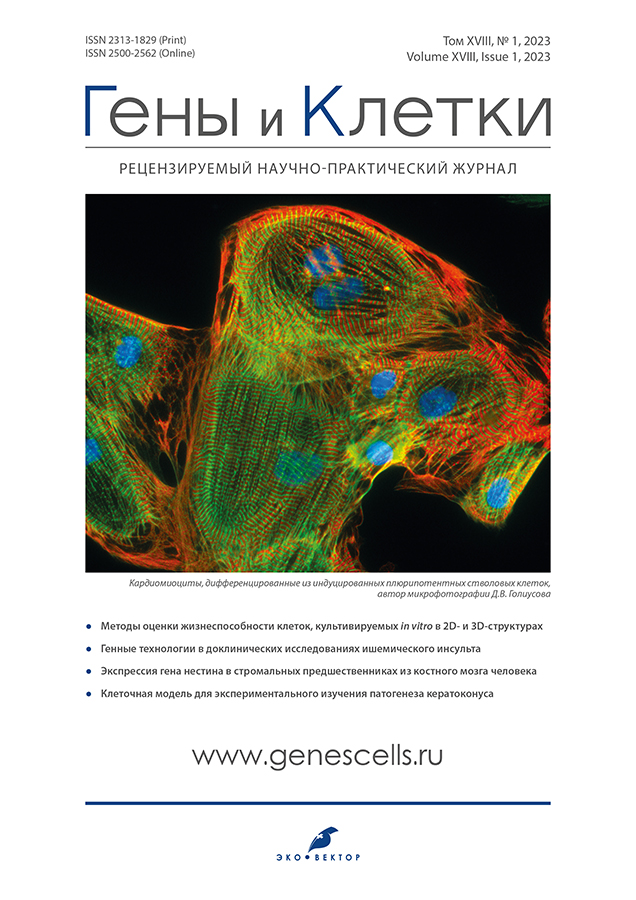Biochemical indicators of sperm plasma and morphofunctional features of spermatozoa in HIV-infected men
- Autores: Starikova T.V.1, Pervova Y.V.2, Shafranskiy I.E.2
-
Afiliações:
- Samara State Medical University
- Medical University "Reaviz"
- Edição: Volume 18, Nº 1 (2023)
- Páginas: 61-67
- Seção: Original Study Articles
- URL: https://genescells.ru/2313-1829/article/view/278906
- DOI: https://doi.org/10.23868/gc278906
- ID: 278906
Citar
Texto integral
Resumo
BACKGROUND: The problem of male infertility particularly affects men with HIV infections, as semen volume and sperm motility are reduced by highly active antiretroviral therapy.
AIM: To analyze the metabolic parameters of spermatozoa, spermograms and spermatozoa morphology in HIV-infected men.
MATERIALS AND METODS: The study included 47 patients (aged 25–46 years) who were under observation at the clinic of Professor M.A. Florova (Samara). 2 groups were formed: main (n=22) — HIV-infected patients who want to have children (with an undetectable viral load (40–50 copies/ml) and taking antiretroviral therapy); control (n=25) — clinically healthy men with one child. The material was taken and the ejaculate was examined according to standardized methods proposed by WHO experts.
RESULTS: In HIV-infected men, spermatozoa motility was low (the number of progressively motile spermatozoa was 28.50±3.72%), the spermatozoa concentration was two times lower compared to the control group of men, the morphological characteristics of spermatozoa were significantly worse than in the control group: most often pathology of the head (21.75±1.10%) and neck of the spermatozoon (22.30±1.18%) was detected, which negatively affects the fertilizing ability.
In HIV-infected men, changes in metabolic metabolism were noted: the activity of creatine phosphokinase in both sperm plasma (661.95±1.08 U/l) and blood plasma (76.90±1.09 U/l) was lower, than in the control group (844.25±0.13 and 79.50±1.37 U/l, respectively), the glucose concentration (8.07±1.14 mmol/l) was 2 times higher than in the control group (3.06±1.09 mmol/l), the concentration of calcium 6.53±0.01 and sodium (119.20±1.23 mol/l) slightly exceeded those in the group of healthy patients (5.55±0.08 and 116.85±0.01 mol/l, respectively). Electron microscopic analysis revealed fragmentation of sperm DNA: the highest percentage of sperm with fragmented DNA was found in men with HIV infection (more than 23%).
CONCLUSION: It was revealed that in vivo fertilization in HIV-infected men is impossible in most cases. The study forms the basis for a future comprehensive assessment of the state of reproductive function in HIV-infected men to assess their fertility and the need for assisted reproductive technologies.
Palavras-chave
Texto integral
Sobre autores
Tatyana Starikova
Samara State Medical University
Autor responsável pela correspondência
Email: stv1591@gmail.com
ORCID ID: 0000-0002-3811-3807
Código SPIN: 9729-6496
Rússia, Samara
Yuliya Pervova
Medical University "Reaviz"
Email: sno1911@mail.ru
Código SPIN: 5770-0961
MD, Dr. Sci. (Med.), Professor
Rússia, SamaraIgor Shafranskiy
Medical University "Reaviz"
Email: Ishafran77@mail.ru
MD, Cand. Sci. (Med.)
Rússia, SamaraBibliografia
- https://apps.who.int/ [Internet]. WHO laboratory manual for the examination and processing of human semen, 5th ed. World Health Organization; 2010. Available from: https://apps.who.int/iris/handle/10665/44261
- Selimova FN, Perminova SG, Mityurina EV, Kozyrina NV. Semen characteristics in hiv-infected men. HIV Infection and Immunosuppressive Disorders. 2019;11(2):94–102. (In Russ). doi: 10.22328/2077-9828-2019-11-2-94-102
- Skakkebaek NE. A brief review of the link between environment and male reproductive health: lessons from studies of testicular germ cell сancer. Horm Res Paediatr. 2016;86(4):240–246. doi: 10.1159/000443400
- Bragina EE, Bocharova EN, Azova MM. Spermatozoon as a vehicle for viruses. International Journal of Cell Science & Molecular Biology. 2017;2(4):2–10. doi: 10.19080/IJCSMB.2017.02.555593
- Camus C, Matusali G, Bourry O, et al. Comparison of the effect of semen from HIV-infected and uninfected men on CD4+ T cell infection. AIDS. 2016;30(8):1197–1208. doi: 10.1097/QAD.0000000000001048
- Coward RM, Stetter C, Kunselman A, et al. Fertility-related quality of life, gonadal function, and erectile dysfunction in male partners of couples with unexplained infertility. J Urol. 2019;202(2):379–384. doi: 10.1097/JU.0000000000000205
- Flegel C, Vogel F, et al. Characterization of the olfactory receptors expressed in human spermatozoa. Front Mol Biosci. 2016;2:389–394. doi: 10.3389/fmolb.2015.00073
- Kaufman JM, Lapauw B, Mahmoud A, et al. Aging and the male reproductive system. Endocr Rev. 2019;40(4):906–972. doi: 10.1210/er.2018-00178
- Zhang Z, Zhang Y, Liu C, et al. Serum metabolomic profiling identifies characterization of non-obstructive azoospermic men. Int J Mol Sci. 2017;18(2):238. doi: 10.3390/ijms18020238
- Medvedeva VV, Malgina GB. Reproductive issues in HIV-infected couples and the possibility of their correction with the help of assisted reproductive technology (a review). Russian journal of human reproduction. 2016;22(2):56–64. (In Russ).
Arquivos suplementares









